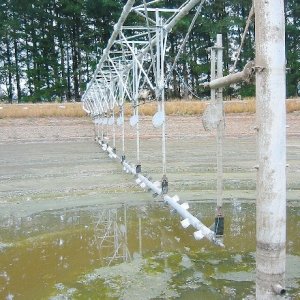But I was too slow to point out to the farmer that those 3000 tonnes of effluent probably contained about 2 t of nitrogen alone. Perhaps $2000 of fertiliser value and soil conditioner was just sitting there in mid June whereas we all know the best place for it is the top 150mm of his paddocks.
If I’d thrown 100 green $20 notes in those holes the message would have been obvious: your effluent pond is not a bank in which you keep your fertiliser funds indefinitely. In this case the stuff should have been on the pasture in the summer or early autumn. (Yes, you must store in during the wet season, but this stuff had been ‘overstored’ if you catch my drift. Ponds are just temporary stopping zones for effluent. I can’t believe the number of lost opportunities I’m seeing.
One of my field day interests is what other manufacturers are doing with effluent equipment. The technology and literature on display is mainly focussed on, and highlights, small developments and improvements to the type of technology that did the same job, but for smaller farms, about 40 years ago. Therefore you still see inefficient pumps in droves as well as masses of localised floating or bank-mounted pond mixers, and many irrigators where the applied amount is just guessed. Never mind that these have seven speeds; the important part is how much they put on the ground, and whether this is less than the soil moisture deficit!
But the sheer mass of this equipment on display is hiding the fact that we have moved on from much of this technology of an earlier time.
Farmers will be blinded to the improvements simply because they have to search through so much of the old stuff to get to the new.
Even the regional council and DairyNZ photos and illustrations probably reassure and lead farmers to believe this older technology is the way forward (it sometimes still could be), but the newer developments and ideas are overwhelmed by the images of the older styles of thinking. There is much comfort to be had by choosing older, ‘safe’ technology, but if you think that way then you’ll still drive a car with no engine management computer, and your only telephone will probably be screwed to the wall in the hallway and have a crank-handle.
Now here’s an apology. When we wrote the new industry standard and code of practice for farm dairy effluent, we actually overlooked something I thought was an ‘assumed practice’ (thorough mixing). We placed a lot of emphasis on irrigators having good uniformity of distribution, and we also suggested the irrigated liquid quantity should be less than the soil moisture deficit. We slipped up especially by omitting to insist on your achieving uniformity in the mixture being irrigated. You may have the perfect irrigator, but if you feed it with ‘thin stuff’ from the upper pond levels (as a floating pump will do) and ‘thick stuff’ as the level falls, then you have bypassed our – even your own – intentions to apply effluent evenly. (Also, I am forming the view that dilute mixtures are better for the pasture itself, and that the thicker mixtures probably are tougher for the field micro- and macro-organisms to handle.)
Frankly, we are seeing too much emphasis being given to floating mixers located in one place in a large pond. You’d be surprised if you could see the underwater effect. They will vigorously stir a local area but there will be quiet, dead spots hidden from your eyes.
This is where the solids and sludges will lurk, becoming underwater islands that will appear as the pond levels fall. Those sludge islands should have gone out through the irrigator. You might also think a tractor- or bank-mounted propeller creating pond circulation is doing a good job. However you can’t see the effect under the water.
But try this test. Half fill a large pot with water. Spread a handful of salt (or clean sand, or rinsed coffee grounds) over the surface and stir until you have circulation. Stop stirring and watch what happens to the salt. From my experience, the pond mixing game has to be greatly improved and I am not impressed with much of the equipment on offer. It has a high energy demand for mediocre effect.
Of course I believe our company has been doing it properly since 2006, but then I would, wouldn’t I.
• Stuart Reid is managing director of Spitfire Irrigators, Upper Hutt.
















